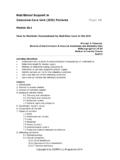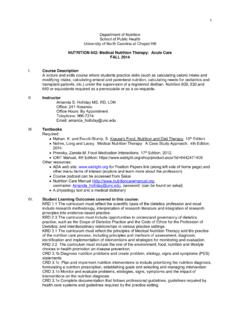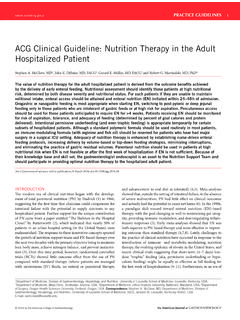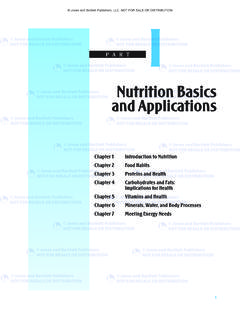Transcription of Malnutrition
1 Copyright 2006 by ESPENM alnutrition Topic 5 Module Undernutrition Simple and Stress Starvation Lubos Sobotka Peter Soeters Remy Meier Yitshal Berner Learning Objectives To know how the body reacts to short-term and long-term starvation during non-stress conditions; To understand the difference between simple and stress starvation; To know the consequences of stress on metabolic pathways related to starvation. Contents 1. Definition and classification of Malnutrition 2. Undernutrition 3. Aetiology of undernutrition 4. Adaptation to undernutrition non stress starvation 5. Stress starvation 6. Summary Key Messages Humans adapt well to short or a longer-term starvation, using their reserve stores of carbohydrates, fat and protein; Reduction of energy expenditure and conservation of body protein are further reaction to starvation. Energy stores are replenished during feeding period; Long-term partial or total cessation of energy intake leads to marasmic wasting; With the addition of the stress response, catabolism and wasting are accelerated and the normal adaptive responses to simple starvation are overridden; Weight loss in either situation results in impaired mental and physical function, as well as poorer clinical outcome.
2 Copyright 2006 by ESPEN1. Definition and classification of Malnutrition Malnutrition can be defined as a state of nutrition in which a deficiency or excess (or imbalance) of energy, protein and other nutrients causes measurable adverse effects on tissue/body form (body shape, size, composition), body function and clinical outcome. In broad term, Malnutrition includes not only protein-energy Malnutrition (both over- and under- nutrition ) but also Malnutrition of other nutrients, such as micronutrients. Malnutrition of micronutrients can cause deficiency states or toxic symptoms - these are discussed in particular modules related to vitamins and trace elements. Fig. 1 Classification of energy and protein Malnutrition MalnutritionOvernutritionUndernutritionM arasmusKwashiorkoror kwashiorkor-like Malnutrition Classification of energy and protein malnutritionObesity The most widely used classification of Malnutrition is based on calculation of body mass index (BMI) see Table 1.
3 Table 1 Classification of Malnutrition according to body mass index 22(Body mass index (BMI) = weight (kg) / body height (m)) Body mass index (kg/m2) Classification Less than Severely underweight Less than 20 Underweight 20 to 25 Desirable or healthy range Over 25 to 30 Overweight Over 30 to 35 Obese (Class I) Over 35 to 40 Obese (Class II) Over 40 Morbidly or severely obese (Class III) 2. Undernutrition Undernutrition can be defined as a state of nutrition deficiency, which is connected with adverse consequences on physical functions or clinical outcome. Usually BMI < 20 kg/m2 identifies high probability of undernutrition. However, individuals with BMI > 20 kg/m2 may be at risk of undernutrition when losing unintentionally more than 10% weight loss over 3-6 months. In opposite weight stable healthy individuals with a BMI < 20 kg/m2 can be without any functional changes related to Malnutrition . Risk of undernutrition related clinical and functional problems can be predicted using nutrition screening tool (see module ).
4 3. Aetiology of undernutrition Undernutrition results from an imbalance among nutrient intake and nutrient needs. The rapidity, severity and clinical outcome of undernutrition are dependent on: difference between energy intake and energy expenditure; Copyright 2006 by ESPEN nutritional status and energy reserves at the onset of the undernutrition - theoretical energy reserves are shown in Table 2; extend of adaptive processes to the undernutrition; potential incidence of stress response ( inflammation, bleeding, surgery) during a period of undernutrition. Table 2 The theoretical reserves of a 74 kg man although survival is unusual when fat content is reduced below 3 kg and protein is depleted by more than 50% (Hill 1992) Body substrate Substrate weight ( kg ) Energy content ( kcal ) Fat 15 Protein 12 Glycogen (muscle) 2000 Glycogen (liver) 800 Glucose (extracellular fluid) 80 Total The main factors that lead to undernutrition are: disease; social and psychosocial factors.
5 Disease-related factors which lead to undernutrition insufficient food/nutrient intake (anorexia, taste disturbances, nausea, vomiting, treatment-induced side effects, eating and swallowing difficulties); impaired nutrient digestion and absorption (especially in gastrointestinal diseases); increased requirements for nutrients (sepsis, trauma, endocrine disease); increased losses ( from wounds, malabsorption and intestinal losses); catabolism. Social and psychological factors which lead to undernutrition problems with shopping or preparing meals; anxiety; depression; poverty; lack of suitable or enjoyable food; environmental factors (nursing homes etc.); inadequate catering practices; anorexia nervosa; hunger strikers. Metabolic consequences of undernutrition are dependent on clinical conditions (adaptive changes of presence of stress, sepsis or critical illness). 4. Adaptation to undernutrition non-stress starvation Development of adaptive mechanisms to food shortage was necessary for survival of famine periods.
6 These adaptive changes allow to healthy subjects of normal initial body composition to survive more than two months of total starvation. Copyright 2006 by ESPENS hort starvation (< 72 hours) Short period of starvation is connected with: diminished insulin and increased glucagon and catecholamine secretions; increased glycogenolysis and lipolysis; hydrolysis of triglycerides in adipose tissue releases fatty acids (FFAs) and glycerol into the circulation; increased gluconeogenesis from amino acids after depletion of glycogen stores. livergluconeo-genesisglycogenperipheryfatglucoseglucose140 g140 gglucose glucose 100100--200 g200 gAA 75 gAA 75 gFA 40 g + FA 40 g + glycerolglycerolFA + FA + glycerolglycerolUncomplicated fasting (12-24 hours) Fig. 2 Metabolic fluxes during short term simple starvation (non stress conditions). Prolonged starvation (> 72 hours) Beyond 72 hours starvation is connected with: further decrease in insulin level; glycogen stores depletion; reduction of energy expenditure related to physical activity; decline in resting metabolic rate by 10-15%; increased -oxidation of fatty acids; increased production of ketone bodies in the liver; adaptation of the brain to using ketones as energy fuel; reduction in net tissue protein catabolism.
7 During simple starvation albumin concentration is unchanged, although plasma proteins with a shorter half-life may be decreased. Fig. 3 Metabolic fluxes during long term simple starvation (non stress conditions). liverketogenesisperipheryfatglucosegluco se60 g60 gketone ketone bodiesbodies+ + glucoseglucoseAA 20 gAA 20 g100 g FA + 100 g FA + glycerolglycerolFA + FA + glycerolglycerolUncomplicated fasting (7 days)ketone ketone bodiesbodies66 g66 ggluconeo-genesisCopyright 2006 by ESPENThe modifications in metabolic processes during short and long term starvation are described in the figure below. Short term starvation (< 72 hours) Prolonged starvation (> 72 hours) Glycogenolysis Depleted glycogen stores Glucose oxidation Glucose oxidation Lipolysis Lipolysis Ketogenesis Ketogenesis in liver Net protein catabolism Net protein catabolism Energy expenditure transiently elevated Energy expenditure Fig.
8 4 The difference between metabolic reactions of short-term and long-term starvation. 5. Stress starvation The reaction to starvation is altered during stress conditions like: burns; necrosis (acute pancreatitis, ischemic necrosis); severe infection and sepsis; penetrating and blunt injury; the presence of tumour cells; radiation; exposure to allergens; the presence of chronic inflammatory diseases; environmental pollutants. In these situations, the normal adaptive responses of simple starvation, which conserve body protein, are over-ridden by the cytokine and neuroendocrine effects of injury (Fig. 5, Fig. 6). Copyright 2006 by ESPEN Effects of cytokines TNF, IL1 and IL6, during injury and infectionRaised blood lipidsGlucose synthesisLoss of lean tissue and fatAcute phase proteinsProduction of oxidant moleculesPlasma ZnPlasma ironPlasma copperFeverAppetite loss and lethargy Fig. 5 Effects of pro-inflammatory cytokines in infection, injury and inflammatory disease TNF-Tumour necrosis factor, IL1- interleukin 1, IL6 interleukin 6.
9 Neuroendocrinestress responseGluconeogenesisMobilisation of substratesglucose/glutamine/fatty acidsProteolysis in peripheraltissuesNegative nitrogen balanceIncreased REEI nsulin and GHresistanceFluid retention Fig. 6 Effects of the neuroendocrine stress response. As a result of cytokine and neuroendocrine reaction to stress the metabolic rate raises rather than falls, ketosis is minimal, protein catabolism accelerates to meet the demands for tissue repair and of gluconeogenesis and there is hyperglycaemia and glucose intolerance. Salt and water retention is exacerbated and this may result in a kwashiorkor-like state with oedema and hypoalbuminaemia (Table 3). The latter may also be exacerbated by protein deficiency. Copyright 2006 by ESPENT able 3 Simple versus stress starvation Simple starvation (> 72 h) Stress starvation Metabolic rate Protein catabolism (relatively) Protein synthesis (relatively) Protein turnover Nitrogen balance Gluconeogenesis Ketosis - Glucose turnover Blood glucose Salt and water retention Plasma albumin - Carbohydrate metabolism Stress initiates a strong increase in endogenous glucose production and turnover.
10 Glucose is an indispensable substrate in this respect because part of the glucose breakdown (glycolysis) does not require oxygen, while still furnishing energy. Lactate as result of anaerobic glucose metabolism is important precursor of gluconeogenesis in liver (Cori cycle). Glucose metabolism during prolonged starvation and stress reaction is shown in Table 4. Table 4 Glucose metabolism during starvation and critical illness Postprandial state Prolonged starvation Stress reaction Gluconeogenesis Glycolysis Glucose oxidation Glucose cycling Protein and amino acid metabolism Amino acids are, together with glycerol, the main substrates for de novo glucose production in the liver. Moreover, particular amino acids, such as glutamine and branched-chain amino acids (BCAA), are the only substrates that can be utilized in some peripheral or wounded tissues as a source of energy and nitrogen.












